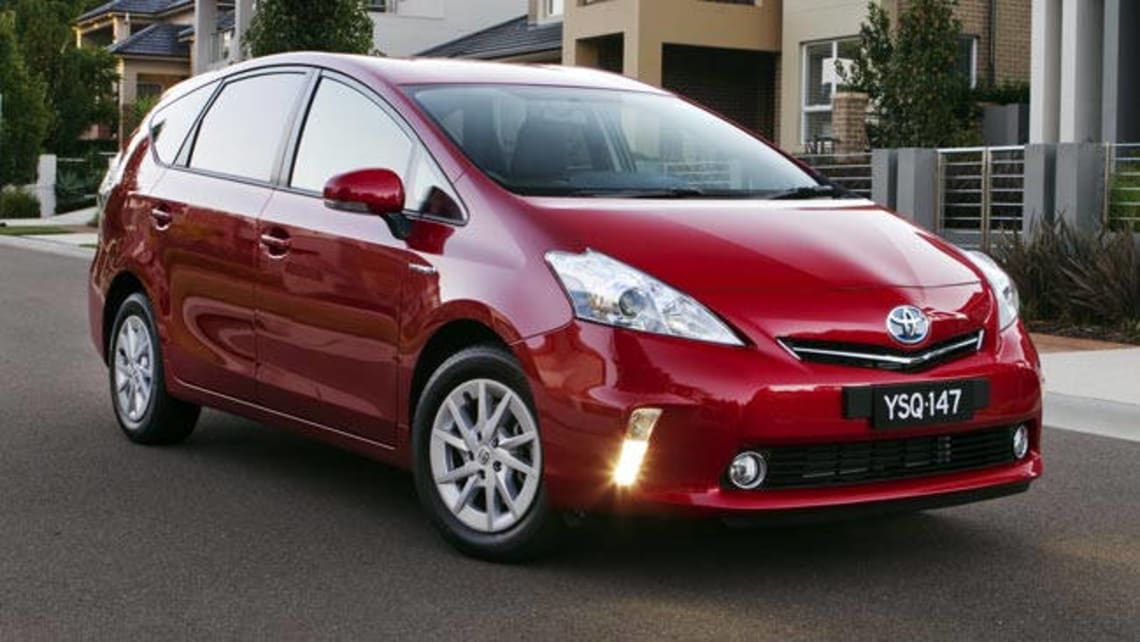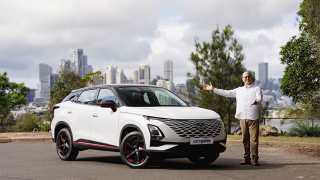
Toyota Prius V 2012 review: weekend drive
- Toyota Prius V
- Toyota Prius V 2012
- Toyota Prius V Reviews
- Toyota Reviews
- Toyota Wagon Range
- Wagon
- Toyota
- EV
- 7 seater

Toyota has launched the third model in its expanded Prius petrol-electric hybrid range with the Prius V compact people mover joining the Prius C small hatch and the original Prius hatch.
We must admit to having a change of perceptions about hybrids following the arrival of these new models as well as the Lexus GS450h and Honda hybrids we reported on recently.
When the earliest hybrids arrived in Australia in the form of the Honda Insight (in Mar 2001) and the Toyota Prius (in October 2001) they were consistently criticised along three lines: their high price, their gawky looks and the discrepancy between their official fuel consumption figures and the ones that we were recording in real-life driving.
VALUE
A dozen years on and the price premium is still there although gradually reducing; the styling has become more mainstream as buyers no longer see the need to boast about their environmental credentials; and the actual fuel usage numbers now seem much closer to the theoretical ones than before.
Just as the Toyota Prius C, launched earlier this year, was a breakthrough hybrid in terms of price, the all-new Prius V is the first seven-seat hybrid and arguably the most versatile, hence the ‘V’ in the name.
Pricing of the Toyota Prius V is a very competitive $35,990, especially good value when compared with Toyota’s previous compact seven-seat people mover, the petrol-powered and only marginally larger Avensis Verso, originally sold for around $10,000 more than this hybrid.
DESIGN
Although there is a clear styling line between the three Prius models, the Prius V is larger in all dimensions than the standard Prius allowing three rows of seats in a two-three-two configuration. All but the driver’s seat can be folded to expand storage space from a very restrictive 180 litres with all seats in place, to 485 litres with the third row folded flat with up to 1020 litres with the centre and front passenger seats also folded.
The optimised space in the Prius V is also helped significantly, firstly by the use, for the first time in a Toyota hybrid, of the more compact lithium-ion batteries, and secondly by their placement in a stacked formation underneath the centre console.
Even though the interior space of the Prius v has been optimised it is still a relatively compact car and so, with all seven seats in place, seating has to be managed. As is generally the case in seven-seaters the rear pair is best left for children – not a problem for the little’uns as the further they can get away from the front seat adults the better they like it. Even then leg room is limited especially when the centre row seats are extended back. As a five-seater though, there are few problems with good headroom in all seats and good luggage space.
Interestingly, Toyota anticipates around 30 per cent of Prius V sales being used as light delivery vehicles of the Volkswagen Caddy type but with the option of increasing seating one-by-one, all seven seats being of the bucket variety. Concave door trim and a wide rear hatch opening also adds to interior space.
TECHNOLOGY
Standard safety equipment in the new Prius hybrid includes seven airbags, stability and traction control, ABS brakes with brake assist and reversing camera. Other features include climate-control air conditioning, USB and Auxiliary sockets, Bluetooth phone and audio streaming and a 6.1-inch touch screen multimedia monitor.
While Prius V does have the instrument panel in the centre of the dashboard the problem of the driver having to move his eyes away from the straight-ahead position is offset by having an adjustable head-up display that projects various functions onto the bottom of the windscreen. These can include vehicle speed, air conditioning temperature, fuel consumption and other features through Toyota’s Touch Tracer system.
ENGINE
Power for the Prius V comes from the combination of a 1.8-litre 73 kW/142 Nm Atkinson Cycle petrol engine and a 60 kW/207 Nm 650-volt electric motor. Combined power is up 100 kW. (The petrol and electric motors don’t generate their maximum power at the same time, so it’s not correct to simply add 73 kW to 60 kW.) The official emission figure of the Prius V is 101 grams per kilometre.
DRIVING
The biggest Prius has the solid, refined feel that we’ve come to expect from Toyota and it cruised effortlessly enough on the open road, although the route chosen did avoid any serious hills and we only had two occupants. We’ll be able to give it a more rigorous workout when we do our usual weekly test.
As fuel prices rise, more and more buyers are factoring in fuel economy to their criteria. So increasingly, when we’re testing new cars, our attention is drawn to the ‘L/100km’ numbers on the instrument panel rather than the ‘km/h’ or ‘rpm’ figures. It certainly was so in our 200-kilometre test drive of the Prius V from the centre of Sydney, through the suburbs and down towards the Southern Highlands, then back to Sydney Airport.
We got some real surprises with actual figures that were only marginally above the 4.4 litres per 100 kilometres of the official Australian standard test and achieved without any serious attempt at economy driving although the fact that we stopped at traffic lights about 30 times before leaving the city prevented us from gaining much momentum and using battery power frequently. But that will be a fact of life for the majority of Prius v buyers, especially those with commercial usage.
This also helps explains why both the city cycle official test and our actual test showed up as lower in both cases than the highway cycle figures, the opposite of what would normally happen. On the outward leg of our 200 km round trip we recorded 5.1 L/100 km while on the return stage, predominantly on motorway running we dropped down to 4.7 litres despite the fact that we were cruising at freeway speeds of around 110 km/h.
VERDICT
Although Toyota Australia doesn’t see the Prius V as competing against the standard Prius, now priced at $33,990, we’re not so sure. For just $2000 more there are significant advantages in interior space, two extra seats with versatile seating arrangements, functionality and higher driving position, many of the attractions that are fuelling the current boom in SUV sales.
$14,990 - $25,888
Based on 5 car listings in the last 6 months
$14,990 - $25,888
Based on 5 car listings in the last 6 months






